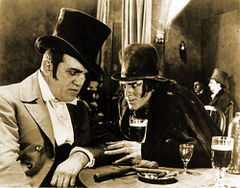How much for a lap dance?
The 1910 Edison film of Frankenstein was itself a dead thing revived by technology. How appropriate, on attempting to review the silent version of The Strange Case of Dr. Jekyll and Mr. Hyde, to discover that I need to present two reviews in one.
J&H may well hold the title of Most Filmed Novella Ever, especially if you count knockoffs of its central premise. It’s been rumored a version was produced in 1897, but no hard evidence exists. The 1908 version has been, apparently, lost. New York-based Thanhouser Films produced the earliest adaptation still surviving, from 1912. The following year saw at least four new versions committed to film, and several others followed before the advent of talkies. For symmetry’s sake, we’ll confine ourselves to two.
Thanhouser produced generally high-quality one-reelers between 1910 and 1917. Their 1912 Jekyll and Hyde may seem clumsy and primitive, but it’s light years more advanced in film technique than Edison’s Frankenstein. Thanhouser’s J&H is notable also for its introduction of romance into Robert Louis Stevenson’s story, beginning a tradition that continues up to the present time. In the original tale, Dr. Jekyll is an elderly hypocrite who, like Faust, regrets he wasted his youth in earning public plaudits while concealing his natural urges. He devises the chemical formula enabling his id to move about independently; Mr. Hyde is born. As Hyde, Jekyll enjoys himself without any scandal, until Hyde becomes the dominant personality. But Stevenson knew exactly what his Victorian readers would stand for, and Hyde’s lusts are never specifically detailed.
Thanhouser’s Jekyll (stock player James Cruze) proceeds from mere scientific curiosity. Reading from a text titled “Graham on Drugs,” which states baldly that a drug exists which will divide the good and evil sides of human nature, he gives it a try. Hyde pops out, a little grinning goblin with fangs, and runs amok in the local village. Realizing his mistake, Jekyll stops his experiments and sets about courting the local minister’s daughter. Alas, merely strolling down a country lane with her is enough to summon Hyde. He assaults her (well, threatens her; this was 1912) and clubs the minister to death when he attempts to defend her. She runs off, finds a convenient British bobby on the streets of New Rochelle, and Hyde is chased back to Jekyll’s laboratory, where he commits suicide.
Paramount’s 1920 Jekyll and Hyde is much more faithful to the original story, and goes into much darker places.
John Barrymore’s Dr. Jekyll is a spotless young saint, running the local free clinic. He is, of course, engaged to a beautiful and innocent girl, but in this case her father is a debauched old gent who persuades Jekyll to try a few nasty pleasures before the wedding night. Jekyll goes along with him to a music hall (nasty? Well, this was 1920) where he is immediately attracted to a sensuous dancer. He wants her! But he can’t have her! Unless… The pure-hearted youth concocts the formula to enable him to purge his vicious longings by creating Edward Hyde.
Barrymore’s Mr. Hyde starts out looking mostly human (Barrymore seems to be doing an impression of his brother Lionel) but wears progressively more appliance makeup as the film progresses, and leaps gleefully over the line into Subhuman. The moment arrives when Jekyll loses control and transforms into Hyde in his sleep, and this is No. 2 on my list of Most Horrific Moments in Silent Film. An immense spiderlike creature crawls from under Jekyll’s bed as he sleeps, and comes up over the foot of it, and advances on him…
Well, you know how the story ends, right? Lots of sex (as much as could be implied in 1920) and violence, and a very bad end for the saintly doctor. And the moral is… but what exactly is the moral? Is it Stevenson’s original premise, substituting Science for Mephistopheles? Or is it Thanhouser’s moral, which simply warns against scientific curiosity? One thing is certain: If you have a brilliant scientist as a prospective son-in-law, think twice before throwing him a stag party.










